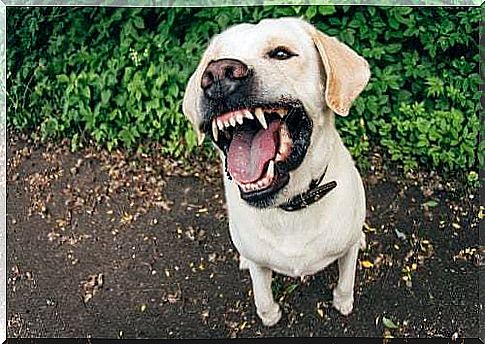6 Common Behavior Problems In Dogs

It is important to learn to interpret certain signals in dog behavior, especially those that manifest themselves with barking, biting, chewing and many other common behavior problems. A solid training base will help prevent and control them better.
Even dogs that usually do well can suddenly exhibit bad behavior. You need to know that dogs don’t have a sense of morality like humans, so they don’t understand when something is wrong or what is right or wrong. They simply do the things that are right to achieve their purpose in that moment.
It should also be noted that, in addition to good training, one way to avoid behavioral problems is to prevent boredom. When a dog has nothing to do, he may start misbehaving and doing things we absolutely want to avoid, such as biting into furniture, playing with shoes or clothes, and obsessively digging. In this article, we will talk about common behavioral problems in dogs.
6 common behavior problems in dogs
Next, we’ll look at some of the more common dog behavior problems and how to fix them.
1. Chewing, one of the most common behavior problems
Chewing is a natural action for all dogs. However, it can become a behavioral problem if the dog destroys things. The most common reasons dogs chew are teething problems (puppies), boredom or excess energy, anxiety and curiosity.
Give your dog toys or objects he can chew on. Also, keep away from him what you don’t want him to bite. If your dog has problems with chewing when you are not at home, leave him closed or confined to an area where he can do damage. When you surprise him by chewing on what he shouldn’t, immediately correct the behavior by replacing the object with a gum-massaging toy.
One of the most important things to do in these cases is to make sure your dog gets enough exercise. This way, he will be able to run out of energy and be sufficiently stimulated, which will reduce his need to chew.
2. Dig
Most dogs instinctively love to dig as soon as they have the opportunity to do so. Some breeds are more prone to this, particularly hunting dogs. In general, most dogs dig out of boredom or excess energy, anxiety or fear, a hunting instinct, others because they seek comfort, to hide something or to escape something.
It is important to determine why the dog is digging. In general, spending more time with him, giving him the opportunity to do physical and mental activity and training him is usually enough to solve the problem. Otherwise, you can always provide him with an area to dig and train.

3. Barking, one of the most annoying behavior problems
Most dogs bark. But excessive barking is considered a behavioral problem. Before correcting it, it is important to determine why the dog is barking. The dog barks to warn or alert, to attract attention, because he wants to play, for anxiety, for boredom or because he is responding to other dogs.
To teach your dog not to bark too much, you need to be consistent and patient. You can also teach him to bark on command with some tricks.
4. To go to the toilet where it is forbidden
Having the dog go to business where it shouldn’t is one of the most frustrating behavioral problems for the owner. First, it is very important to discuss this with your vet to rule out any health problems. If there is no medical cause, the problem could be due to submissive or emotional urination, attempting to mark territory, or wanting to demand attention. It could also be an anxiety problem.
Inappropriate evacuation is inevitable in puppies, especially before 12 weeks of age. From now on, it will be necessary to train them. For adult dogs that have already been trained, the problem usually requires serious behavior modification to break the habit.
5. Bite people
Dogs bite for various reasons. For example, herd instinct and mentality can be a reason. Pups bite other dogs and people to explore their surroundings and learn their place in the pack. Training plays a vital role in avoiding this behavior in puppies.
But beyond that, the reason a dog bites usually comes from fear, from a defensive attitude, to protect property, from pain or disease, to assert dominance, or from the predatory instinct itself.
Owners and trainers should try to reduce the dog’s tendency to bite through proper training and training, socialization and adaptation practices.

6. Aggression
Aggressive dogs growl, show their teeth, and eventually bite. Among the common behavioral problems in dogs, it is important to know that every dog is potentially aggressive, regardless of breed or past. However, dogs that have experienced abuse and violence and those raised alongside other dogs with aggressive tendencies are much more likely to exhibit aggressive behavior towards people or other dogs.
The reasons for aggression are basically the same as the reasons for a dog to bite, but canine aggression, in general, is a much more serious problem. If a dog has aggressive tendencies, it is advisable to see your vet, as it could be due to a health issue. It is also advisable to contact an experienced dog trainer.









